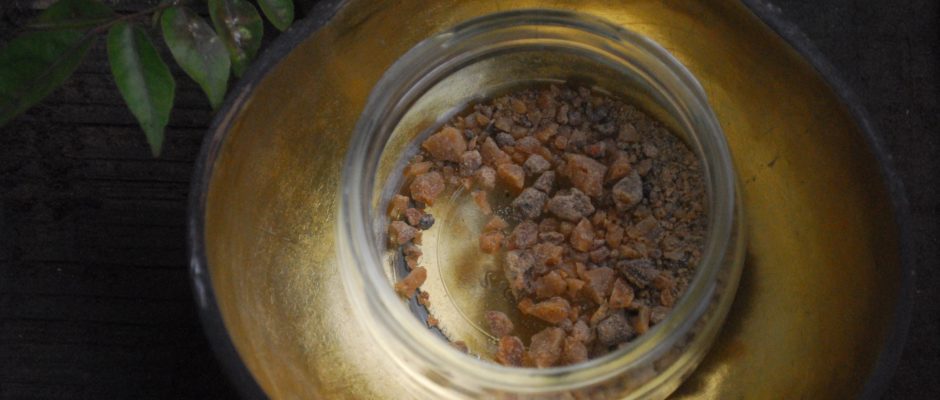Simplicity Coimbatore ,Asafoetida in it’s pure form
A month ago , a school mate of mine currently living in the US messaged me wanting to know more about asafoetida. She enjoys cooking Indian meals for her family and therefore the perungayam is a much used condiment in her kitchen.
Her interest got me thinking about this pungent ingredient which is such an integral part of the Indian kitchen. In our South Indian homes no paruppu , sambhar ,rasam or pickle making is complete without the perfunctory sprinkling of this unique spice.

I knew that it was actually the resin of a plant but beyond that I confess that my knowledge of asafoetida was rather limited. It also came to my recollection that another friend had mentioned that the perungayam powder or hing which is available in bottles is mixed with maida flour and Arabic gum. It was not a pleasant revelation in the least. However it was something I didn’t need to worry about since we always bought the perungayam in chunks and powdered it at home…or so I thought ! While on the asafoetida learning process,I was dismayed to find out that even the whole blocks contained a large percentage of refined flour as well as arabic gum.

So thus began the journey of unearthing a more purer form of perungayam (asafoetida).It wasn’t easy. The brands that do sell the perungayam blocks insisted that it had a very short shelf life without the addition of refined flour. I also had a conversation with Mr.Parthibhan of Seeragam-the natural store. Their process of storing perungayam seemed a lot better because instead of refined flour they used arrowroot powder.

Still keen on locating a store where perungayam would be sold in it’s traditional form, the search went on for a few more days. The town hall area of Coimbatore is known for it’s quaint nattu marundhu (herbal) shops . No native ingredient search would be complete without rummaging through those small streets and alleyways.At Raja street,we were pointed in the direction of Meera Traders. Lo and behold !..they sold asafoetida blocks in it’s natural state.With a kilogram of pure asafoetida costing close to Rs.15,000 ,the proprietor ,M.Kadhar Sheriff has it packed in small sachets of 5 gms at Rs.75 each. He has been selling this special grade of perungayam for the past 9 years . A friend up north who was supplying the pure ,aged form of this resin to pickle companies began selling a small quantity to Mr.Sheriff as well. The availability of this ingredient at his store has spread purely through word of mouth and there are customers now who come from Erode and Salem just to buy this one spice from this shop. Mr.Sheriff remembers that when he first started a 5gm packet cost a small sum of Rs.5.Now with more people understanding the ingredient’s worth ,the price has gradually escalated. He is quite emphatic that the perungayam will not spoil if kept in an airtight tin!

His customers are mainly the local , Brahmin and chettiar community who add a lot of hing in their daily cooking.Mr. Sheriff cautioned me to use just a mustard seed size quantity to flavour each dish,not more. He assures me that having used it in pure form, we will be coming back for more. Coimbatore comprises of large communities of vegetarians.The Jains , Gujaratis, Iyers, Iyengars and Marwaris do use asafoetida in a variety of dishes ranging from poriyal ,to kadhi and aachaar and more.
Interestingly the asafoetida does not have it’s origins in India. It originated in the European continent where it is believed that the Romans spread this spice liberally on their meats before roasting. It is a far cry from the staunch Indian vegetarians who rely on this flavour for their traditional recipes. The Western nostrils today may not survive the distinct odour of the asafoetida but back in the day it was used as a substitute for onions and garlic. In fact, the asafoetida is ,today, a forgotten ingredient in modern European cuisine.

When the asafoetida is cooked in oil,the aroma turns more appetising and lends a peculiar but pleasing flavour. We have all been told by our elders that the perungayam is essential for digestion. Along with the mustard seeds and curry leaves, a teeny pinch of perungayam is a vital part of the tempering process. Hing goli made with perungayam,tamarind,jaggery and saltis a much loved after meal digestive.
What we also discovered is that the leaves of the asafoetida plant are also edible.They give off the same smell because the sap originates from the stems. When the leaves are cooked the unpleasant odour dissipates.The life cycle of the plant ends after it flowers (after several years) The seeds that form in the flower head ,fall and give rise to new plants.
In order to collect the resin an incision is made at the base of the plant and the clear sap is collected over a period of 3 months after which the plant withers. The sap is then aged and then mixed with flour and gum, powdered and sold in containers. How such ingredients were discovered and experimented with food is a constant point of fascination for me and fuels my passion to learn more.
Having bought the purest form of perungayam, my kitchen will begin to make the switch from powder to resin. For me this is important because if I have a choice it would be to not eat a refined ingredient mixed into a spice. So starting tomorrow,a pin head dot of pure perungayam will go into my rasam.
CONTACT – for pure perungayam
Meera Traders- M.Kadhar Sheriff
Phone: 2392399 , 9443139238
218 Raja Street,
Coimbatore-641001


No comments yet.